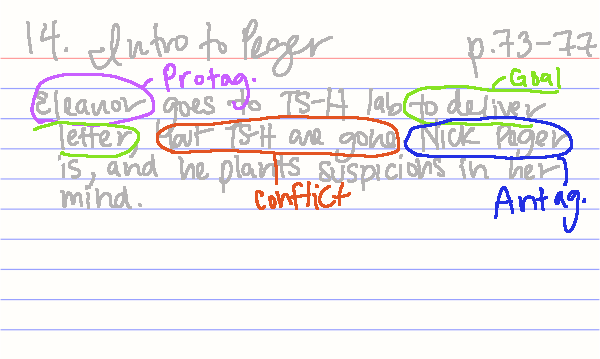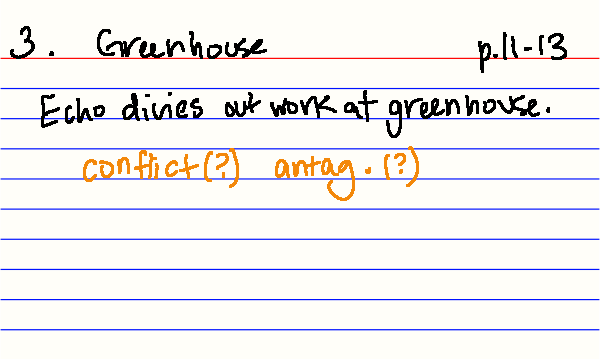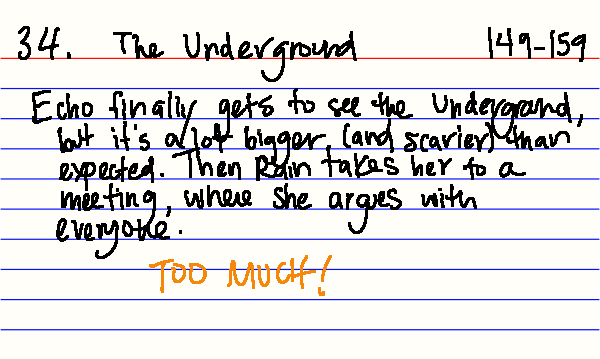Sooz’s Guide to Revisions, Lesson 2: Let’s get organized.
When you finish Lesson 1 (don’t worry if it takes a while!), your next objective will be to make an outline. Outlines help you see the WHOLE BOOK in a single glance–er…in a glance or two.
Being able to quickly isolate scenes and segments without flipping through the whole novel will save you time. LOTS of time. I promise–once you start outlining before revisions, you will never go back!
Supplies needed today:
- index cards
- your printed manuscript
So let’s get organized, umkay?
1. First off, I suggest you make your outline on index cards.** On these cards, you will be writing a summary of each scene. If you wish to read the novel a second time to make the outline, go for it. Only you know what you’re capable of–I usually have a fresh idea of the novel, so I merely skim through it to make the outline.
2. BE SURE to number the scenes in order. You can use whatever numbering system you like (like: 4-1 = Chapter 4, scene 1; or 36 = scene 36) but the key is to stay organized.
3. BE SURE to include the scene pages on the card. This allows you to quickly go to the scene you’re working on without having to scour the manuscript to figure out where it is.
4. On each scene card, you will include (see pictures):
- Protagonist
- Antagonist (this can be a person, thing, or situation)
- Scene Goal
- Scene Conflict (what is it that keeps the Protagonist from achieving his/her goal?
**You don’t have to use index cards. If it’s easier for you to just type the outline, go for it. I like index cards because they’re easy to see one-at-a-time, easy to shuffle and reorganize if needed, and have plenty of space to add the post-its you’ll be using later on.
Again, this might take some time since you’re isolating lots of stuff into single sentences.
5. Now is also the time to start looking for two problems:
Scenes that do too much
Scenes that do nothing
Scenes that do too much: These are the scenes that are simply too long. Sometimes, if the action is high energy, a 15 page scene will work. But usually, that’s too much. Sometimes, having 5 new information reveals or turning points in a scene is okay, but usually that’s too much.
– To tell if you have too much, isolate how many goals are achieved/thwarted. If the scene goal changes several times, you might have too many things in that scene!
– Also, consider length. Readers want natural pauses and endings, so you never want a readers with glazed-over eyes who’s just trying to get to the end so he/she can set the book aside. No good!
Scenes that do nothing: These are the scenes in which (as the name implies) nothing happens. The stereotype is a scene where characters sit around and drink tea. Unless that tea is poisoned or the conversation is majorly revealing, it simply doesn’t belong in your novel. Every scene must further your story!!
– To tell if you have a “nothing scene”, look at your outline. If there is no scene goal or there is no scene conflict, then you’ve got a problem.
6. If you find you’ve got a scene like that, simply slap a post-it on there that explains it. Or, you can do what I do:
7. Once you reach the last scene, make sure your cards/outline is organized and stowed away safely. You’re done with Lesson 2!
Wrapping Up
That’s everything for Lesson 2! Stay tuned for the next lesson, coming tomorrow. In Lesson 3, we’ll be setting our goals and planning the Perfect Book!
For now, get to work on that outline and start looking for weak scenes!
And if you have ANY questions, ask them in the comments!!
Lesson 1 → Lesson 2 → Lesson 3 → Lesson 4 → Lesson 5 → Lesson 6 →





May 16, 2011 @ 2:31 pm
I don’t necessarily use index cards, but I do go scene by scene to assess the conflict, character, etc like you say. 🙂
And the comment about tea being poisoned made me laugh. 😉
May 16, 2011 @ 6:59 pm
I’m glad poisoned tea makes you laugh. 😀 Oy, you don’t know HOW MANY scenes I wrote in my first novel where the characters did nothing but drink coffee and talk. SO BORING.
May 16, 2011 @ 2:42 pm
I’ve tried the index card method, but it turns out just typing every scene out chronologically in one Word document helps me see the big picture better. But yes, I definitely follow your method of making sure every scene has a purpose. I definitely have a nothing scene in my WIP that I just wrote yesterday. It’s basically just two characters getting from point A to point B … and that’s it. It’s getting tossed today. 😉
May 16, 2011 @ 2:43 pm
I say “definitely” a lot, don’t I? 😀
May 16, 2011 @ 6:57 pm
Hahaha, and I like it a lot. 😀 Have you seen the ALOT monster on Hyperbole and a Half?
May 16, 2011 @ 6:58 pm
Ah, yes! I’ve read your outline before. 😉 And whatever works, you know? If a typed outline works, go for it! I need the index cards since I go so CRAZY with the post-it notes…as you’ll see in a later lesson.
May 16, 2011 @ 6:54 pm
This might’ve been covered elsewhere and my apologies if it has – but on average how many scenes do you have per chapter? Do your chapters tend to be about the same length? This is definitely an area I’m a bit unsure about!
As always, thank you for sharing your wealthy of knowledge and tried and true tactics! 🙂
May 16, 2011 @ 6:57 pm
My chapters tend to be 15-20 pages. My scenes are 4-8, though some (like climax scenes) will run over 15 pages. I usually have 2-3 scenes per chapter, but if it’s a long scene (i.e. 15 pages or above) then it might be it’s own chapter.
I hope that helps! I write with really natural breaking points (probably because my scenes always follow that protag-antag-goal-conflict formula). 🙂
May 17, 2011 @ 1:44 pm
Awesome – thanks for the info! I think I manage to have a random stack of books at my desk because they all vary quite a bit, but it’s nice to have a basis of comparison.
May 17, 2011 @ 7:54 pm
I love the color-coding tips, Susan! I’m going to ttry that with the rewrite I’m working on now.
I, too, use index cards to map out my scenes. I find myself shuffling the cards incessantly, trying to find the right pace. Recently I scrapped a scene that I loved (OMG. It hurt. It hurt SO bad to do that) because it didn’t add anything and it actually slowed Act I. Without the index cards, I wouldn’t haev picked up on that error.
May 18, 2011 @ 6:08 pm
sitting around drinking tea! I love it. I laughed out loud here at the coffee house and everyone turned to look at me 🙂 I am just catching up on these posts and I am so excited since I am halfway through my notecards now– thank you Susan, goddess of writing!!
May 18, 2011 @ 7:12 pm
Hahaha, you laughed at drinking tea while you were drinking coffee. 😉
And you are so very, very welcome!!
January 27, 2014 @ 6:12 pm
I’m having a hard time figuring out what qualifies as a “scene”–do they become new scenes whenever someone new enters, or is just one person’s experiences until a break?
January 27, 2014 @ 6:27 pm
Hi Clark. Scenes are the building blocks of a story–their the natural breaks in the ebb and flow of what’s happening. Look at any book and you’ll see these breaks between scenes (usually denoted by an empty line), or sometimes chapters serve as an scene.
Here are some posts on scenes that I hope help you: http://hollylisle.com/scene-creation-workshop-writing-scenes-that-move-your-story-forward/, http://letthewordsflow.wordpress.com/2011/02/16/scenes-what-are-they-in-novels-and-how-do-you-write-them/
November 30, 2014 @ 6:06 pm
Just a question – a lot of my scenes are missing one element out of the four you’ve listed. They /are/ important scenes because they reveal a lot, but I think because they don’t have conflict, they feel like filler. Any suggestions on how I could fix that? :/
December 3, 2014 @ 11:47 pm
You know…I made this guy 4 years ago. So my process has evolved A LOT, and my idea of what’s needed in a scene has evolved too. If the scene feels right, then keep it. If it feels like the lack of conflict is a PROBLEM, then see if you can reveal all of that same info in other scenes. 🙂
December 4, 2014 @ 10:08 am
Thanks! 😀
February 5, 2015 @ 12:19 pm
Yeah, my scenes are not very action oriented – it’s a human-interest story about health, and whilst the direction by each scene is moving ‘forward’ it’s kinda hidden, I suppose the antagonist and protagonist in this story is the emotion and the illness taking hold of the main character and the emotional changes. I’m thinking of weaving through some back story scenes though that actually have some action – I have a few already so I’m already partly the way there. 🙂